Notes For All Chapters Biology Class 11 CBSE
Topic 1 Musculature : Structure and Functions
Movement
Movement is defined as any visible change of position, exhibited either by the whole organism or any part of the body. It is one of the important characteristics of living organisms.
The movement of living things are autonomic (self-sustained) while, the movement of non-living objects is induced (due to external forces). Both animals and plants exhibit wide range of movements. Movement of animals can be muscular and non-muscular. Plants show cellular and often organ movement, but not the movement of the organism. The study of movement is called Kinesiology.
Types of Movement
Three main types of movement are exhibited by the cells of the human body. These are as follows
1. Amoeboid (Pseudopodial) Movement
Movement with the help of finger-shaped protoplasmic extensions (i.e., pseudopodia or false feet) (as seen in Amoeba) is called amoeboid movement, e.g., Movement of leucocytes and macrophages in blood. Cytoskeletal elements, like microfilaments are also involved in this type of movement.
2. Ciliary Movement
Movement with the help of cilia is called ciliary movement. Cilia are short, fine, hair-like structures present all over the body surface in large numbers, which beat in succession in coordinated manner to help in locomotion, e.g., Removal of dust particles and foreign substances through the trachea, passage of ova through female reproductive tract.
This type of movement occurs in most of our internal tubular organs that are lined by ciliated epithelium.
The above two movements are called non-muscular movements.
3. Muscular Movement
Movement with the help of muscles is called muscular movement. These are brought about by the movement of myofilaments packed within the muscle fibres. The contractile property of muscles is used effectively to bring about a movement. This type of movement is found in majority of multicellular animals including humans.
Locomotion
It is the movement of an animal as a whole from one place to another. These are vpluntary movements that results in change of place or location. It requires a perfect coordinated activity of muscular, skeletal and neural system. Locomotion takes several forms such as walking, running, flying, swimming, etc.
Advantages of Locomotion
It helps the animal in search of food, shelter, mate, to escape from enemies/predators, to locate suitable areas for breeding or to disperse to new locations. Methods of locomotion in animals vary with their habitats and the demand of situation.
Locomotion v/s Movement
It is very difficult to separate movement from locomotion because an animal cannot change its place (locomotion) without movement, e.g., Cilia helps in movement of food inside cytopharynx and in locomotion in Paramecium. Tentacles in Hydra are used for capturing prey and in locomotion.
Limbs are used for change of body postures as well as for locomotion in humans.
This suggests that movements and locomotion are interlinked thus, stating that all locomotions are movements but all . movements are not locomotions.
Muscles
These are made up of highly specialised thin and elongated cells called muscle fibres. Muscles arises from the embryonic mesoderm. It makes about 40-50% of a human body weight.
Special Properties
Muscles exhibit various special properties, some of them are given below
(i) Contractibility The cells of muscle can be shorten considerably and return to the original relaxed state.
(ii) Excitability It is due to the energy stored in the electrical potential difference across the plasma membrane.
Other distinguishing properties are extensibility and elasticity.
Note:
* Muscle Tissue is the most abundant tissue in most animals.
* Human body has some 639 separate muscles that bring about movement in majority of animals.
* The study of muscle is called Myology.
• Muscles of iris and ciliary body are ectodermal in origin.
• The largest/biggest muscle in human body is gluteus maximus (hip muscle), the longest muscle is sartorius (back muscle), the strongest muscle is masseter (jaw muscles).
• The longest smooth muscle is rectus abdomins and the shortest muscle is stapedial muscle.
Types of Muscles
Muscles have been classified using different criteria,
i. e., location, appearance and nature of regulation of their activities.
Based on their location, the muscles are of three types, i.e., skeletal, visceral and cardiac.
i. Skeletal or Striated Muscles
It functions in association with the skeleton of organism. Under the microscope, they have a striped appearance and hence are called striated muscles.
They are also known as voluntary muscles as their activities are under the voluntary control of the nervous system. The major component of muscles is water and potassium is the most abundant mineral element.
They are primarily involved in locomotory actions and change of body postures.
ii. Visceral or Smooth Muscles
They are found in the inner walls of hollow visceral (internal) organs of body like alimentary canal, reproductive tract, etc.
They do not exhibit any striation, i.e., smooth in appearance and hence, are called smooth muscles (non-striated muscle). They are also known as involuntary muscles as they are not under the voluntary or direct control of the nervous system.
They assist in the transportation of materials, e.g., Movement of food through the digestive tract and gametes through the genital tract.
iii. Cardiac Muscles
It occurs in the wall of the heart and in walls of large veins (e.g., Pulmonary veins and superior vena cava), where these veins enter the heart. These are striated and involuntary in nature. Oblique bands and intercalated discs are their characteristic feature.
It assembles in a branching pattern to form a cardiac muscle. They never get fatigued.
Note:
* Two types of muscles fibres are found in the body. Slowtwitch (in muscles that require endurance) and fast twitch (in muscles that contract quickly.)
* High intensity exercise causes an increase in muscle mass, while low intensity exercise, aerobic exercise, build mass, but do not burn colonies.
Detailed Structure of a Skeletal Muscle
Skeletal muscle is made up of a numbed of muscle bundles or fascicles held together by fascia (collagenous connective tissue layer).
(plasma membrane) and contains well developed endoplasmic reticulum (sarcoplasmic reticulum), specialised for calcium storage in its sarcoplasm (cytoplasm).
Muscle fibre is a syncitium as the sarcoplasm contains many nuclei. There are large number of parallely arranged filaments called myofilaments or myofibrils (characteristic feature of muscle fibre).
Detailed Study of a Myofibril
A myofibril has alternate dark and light bands. The dark bands are also called A-band (anisotropic band) and contains protein myosin. The light bands are also called I-band (isotropic band) and contains actin.
The striated appearance of myofibril is due to the distribution pattern of the proteins actin and myosin. Both these proteins are arranged as rod-like structures, parallel to each other and also to longitudinal axis of myofibrils. Actin filaments are thinner than myosin filaments, hence are usually called thin and thick filaments respectively.
Composition of Muscle Bundle
Each muscle bundle contains a number of muscle fibres (muscle cells), bounded by sarcolemma
Each I-band has its centre, a dark membrane called Z-line (an elastic fibre). It is also called Z-disc or Krause’s membrane or Dobie’s line. The part of the myofibril between two successive Z-lines is a called a sarcomere (functional unit of contraction). A sarcomere consists of the A-band and half of each adjacent I-band. A thin fibrous membrane called M-line present in the middle of A-band holds the thick filaments together.
The A and I-bands are arranged alternately throughout the length of myofibril. At the centre of A-band, a portion is present that is not overlapped by thin filaments. It is called the H-zone (Hensen zone).
In resting state, the edges of thin filaments on either side of thick filaments partially overlap each other leaving H-zone in the centre of thick filaments.
Structure ot Contractile Proteins
The thick myofilaments are formed by myosin protein. The thin myofilaments are formed by three types of proteins called actin, tropomyosin and troponin. These four proteins are collectively known as contractile proteins.
Thick Myofilament or Primary Myofilament
It consists mainly of myosin protein. Each myosin filament is a polymerised protein, made up of many monomeric proteins called meromyosins.
Each meromyosin has two important parts as follows
Globular Head
It has a short arm, called heavy meromyosin (HMM). The HMM components projects outwards at regular distance and angle from each other, from surface of a polymerised myosin filament and known as cross arm. The globular head is an active ATPase enzyme, which has binding sites for ATP and active sites for actin.
Tail
Tail is called the light meromyosin (LMM). The myosin molecule has two identical heavy chains and four light chains. The two heavy chairis wrap spirally around each other to form a double helix. The light chains are the parts of the myosin heads and help control the function of head during the contraction of muscle.
Thin Myofilament or Secondary Myofilament
It is composed of following proteins Actin
It is a globular protein with low molecular weight. It is made up of two ‘F’ (filamentous) actin helically wound to each other. Each F actin is a polymer of monomeric ‘G’ (globular) actins.
Tropomyosin
Two filaments of. this protein run close to the ‘F’ actions throughout its length.
iii. Troponin
It is a complex protein of three globular peptides (Troponin T, Troponin-I and Troponin-C) distributed at regular intervals on tropomyosin.
In the resting stage of muscle fibre, a subunit of troponin masks the active sites for myosin on the actin filaments.
Note:
* Partial overlapping of primary myofilaments by the secondary myofilaments imparts dark appearance to the A-bands.
* The strong affinity of the troponin for calcium ions is believed to initiate the contraction process.
Mechanism of Muscle Contraction
The contraction of muscle is best explained by the sliding filament theory. It states that contraction of muscles takes place by the sliding of thin and thick filaments that past over each other with the help of cross-bridge to reduce the length of the sarcomere.
This theory was proposed independendy by AF Huxley and R Niedergerke and by HE Huxley and Jean Manson in England in 1954.
The sequence of events leading to contraction is initiated by a signal in the Central Nervous System (CNS), either from the brain (voluntary activity) or from spinal cord (reflex activity) via a motor neuron.
A motor neuron along with the muscle fibres connected to it, forms a motor unit and the action potential is conveyed to a motor end plate (or neuromuscular junction) i.e., the junction between a motor neuron and sarcolemma of muscle fibre) on each muscle fibre.
A neurotransmitter (acetylcholine) is released at the junction by the neural signal which generates an action potential in the sarcolemma. This spreads and causes the release of calcium ions into sarcoplasm.
Calcium plays a key regulatory role in muscle contraction. Increase in calcium ions level leads to their binding to troponin subunit. Thus, exposing the active sites on F-actin molecules.
Formation of Cross-Bridge
An ATP molecule joins the active site on myosin head of myosin myofilament. These heads contains an enzyme, myosin ATPase that along with Ca2+ and Mg2+ ions catalyses the breakdown of ATP.
The energy is transferred to myosin head, which energises and straightens to join an active site on actin myofilament, forming a cross bridge.
The energised cross-bridges move, causing the attached actin filaments to move towards the centre of A-band. The Z-line is also pulled inwards causing shortening of sarcomere, i.e„ contraction. It is clear from the above explanation that during contraction A-bands retain the length, while I-bands get reduced.
The myosin head releases ADP and Pi, relaxes to its low energy state. The head detaches from actin myofilaments when new ATP joins it (cross-bridge broken).
In repeating cycle, the free head cleaves the new ATP. The cycles of cross bridge formation and breakage is repeated causing further sliding.
Muscle Relaxation
After contraction the calcium ions are pumped back to the , sarcoplasmic cisternae, blocking the active sites on actin myofilaments. The Z-line returns to original position, i.e., relaxation.
Note:
Rigor Mortis is the state of body stiffening after death due to non-separation of actin and myosin filaments caused by non-availibility of ATP. It appears first in the small muscles of the face (such as jaw) and those being used most actively prior to death. It persists till decomposition starts.
Red and White
Birds and mammals have two kinds of striated muscle fibres, in their skeletal muscles, i.e., red (or slow) and white (or fast) muscle fibres.
Differences between Red and White Muscle Fibres
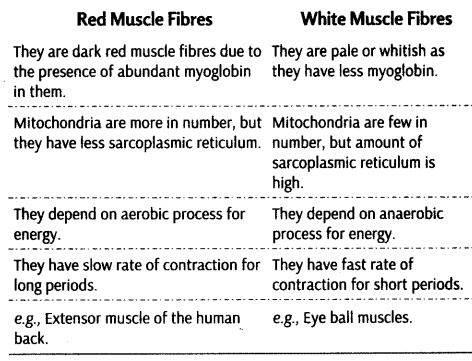
Skeleton (Skeletal System)
The hard, supportive or protective elements of the animal body constitute the skeletal system or skeleton. It consists of a framework of bones and a few cartilages. Both of them are specialised connective tissues.
Bone has a very hard matrix due to calcium salts and made up of a protein called ossein.
Cartilage has slightly pliable matrix due to chondroitin salts. It is made up of a protein called chondrin.
Bone consists of a dense outer layer known as compact bone and spongy layer inside called spongy bone.
Bones are remodeled for strength when exposed to new stresses.
Functions of Skeleton
Skeleton serves to perform following functions
(i) Support It gives support to softer body parts.
(ii) Protection It protects the delicate internal organs like brain, heart, lungs, etc.
(iii) Muscle attachment Provide surface for attachment of muscles.
(iv) Movement Bones helps in bringing about movements also.
(v) Blood cell formation To manufacture blood corpuscles in bone marrow.
(vi) Helps in breathing and hearing Tracheal rings, sternum and ribs are helpful in breathing, while ear bones (middle ear) transmit sound vibrations.
Human Skeleton
Human body is made of 270 bones, which are fused variously to form 206 bones.
On the basis of the position of the skeletal structures in the body, the endoskeleton is divisible into two parts
(i) Axial skeleton It comprises of 80 bones, which
includes skull, vertebral column, ribs and sternum.
(ii) Appendicular skeleton It lies along the transverse (side) axis. It comprises of 126 bones, which , includes pectoral and pelvic girdles and limb bones, i.e., bones of arms and legs).
Note:
* Bones are of four categories according to size and shape, i.e., long, short, flat and irregular bones.
* Smallest bone is Stapes.
* Longest and strongest bone is Femur.
* Funny bone is Olecranon process on top of the ulna.
* There are remarkable differences in the skull of male and female, thus, together with the pelvis it is used for identification of sex.
Skull
It is the bony framework of the head. It is composed of two set of bones (cranial and facial) that forms total of 22 bones [bones of middle ear (6 bones) and hyoid bone (1) are also included in bones of skull].
Bones of skull are as follows
(i) Cranium — 8 includes frontal (1), parietal (2), temporal (2), occipital (1), sphenoid (1), ethmoid (1). They form the hard protective outer covering (cranium) for the brain
(ii) Facial bones — 14 includes maxillae (2), palatine (2) mandible (1), vomer (1), nasal (2), zygomatic (2), lacrimal (2), inferior turbinate (2)
They form the front part of the skull
(iii) Ear ossicles — 6 includes, 2 malleus, 2 incus, 2 stapes
These three tiny bones belong to the middle ear.
(iv) Hyoid A U-shaped bone present at the base of buccal cavity. It is the only bone which is not in contact with the another bone. This is also called tongue bone. Human skull is dicondylic, the skull region articulates with vertebral column with the help of two occipital condyles.
Vertebral Column
It is also called backbone or spine. It is dorsally placed, extending from the base of the skull and constitutes the main framework of the trunk.
It is made of, 26 serially arranged units called vertebrae.lt includes cerical or yes bone (7), Thoracic
(12), Lumbar (5), Scaral or Sacrum (1-fussed) and
coccygeal (1-fused). The vertebral formula for humans is C7,T12,L5,S5,C(3-5).
Note:
* Altas is the first vertebra and it articulate with the occipital condyles.
* The number of cervical vertebrae is 7 in almost all mammals).
* Lumbar is the largest and the strongest in the vertebral column.
Vertebral column performed following junctions
(i) provides protection to the spinal cord,
(ii) supports the head,
(iii) allows flexion and bending of the back and body
(iv) also serves as point of attachment for the ribs.
Sternum
It is a flat daggar-shaped bone located on the ventral midline of thorax.
Ribs
These are the thin, flat curved bones that form a protective cage around the organs of upper body. The ribs are composed of 24 bones arranged in 12 pairs, connected dorsally to thoracic vertebrae and ventrally to sternum by hyaline cartilage. It has two articulation surfaces on its dorsal end and hence called bicephalic.
True Ribs
The first seven ribs are attached directly with the sternum and are called true ribs.
False Ribs
The 8th, 9th and 10th pairs of ribs join the seventh rib with the help of hyaline cartilage. They do not articulate directly with sternum. Hence, are called vertebrochondral (false) ribs.
Floating Ribs
The last two (11th and 12th) pairs of ribs remains free anteriorly and are called floating ribs.
(i) they protect the heart, large blood vessels and lungs.
(ii) bear respiratory muscles.
(iii) also lower two pairs of ribs also protect the kidneys.
Thoracic vertebrae, ribs and sternum together form the rib cage.
Limbs
The bones of the limbs alongwith gridles constitute the appendicular skeleton. Each limb is made of 30 bones.
Forelimb
The bones of the hand (forelimb) constitutes
Humerus (1), Radius (1), Ulna (1), Carpals/wrist bones (8),
Metacarpals-palm bones (5) and phalanges/digits (14).
The humerus and ulna together make up the below.
The ulna is longer than the radius and connects more firmly to the humerus.
The radius contributes to the movement of the wrist.
The phalangeal formula for human hand is 2, 3, 3, 3, 3.
Pectoral (Shoulder) Girdle
It consists of following two bones, i.e., scapula and clavicle.
i. Scapula (Shoulder Blade)
It consists of a sharp ridge the spine and a triangular body. The end of spine projects as a flattened and expanded portion called acromion. This articulates with the clavicle.
Glenoid cavity is a depression below the acromian to which head of humerus articulates forming shoulder joint.
ii. Clavicle (Collar Bone)
Each clavicle is a long slender bone with two curvatures. The clavicle helps in articulation of the upper limb with axial skeleton.
This provides an attachment point for numerous muscles that allow shoulder and elbow joints to move.
Hindlimb
The bones of the leg (hindlimb) constitutes
Femur (1), Tibia (1), Fibula (1), Tarsals (7), Metatarsals (5)
and phalanges (14).
A cup-shaped bone called patella cover knee ventrally. It is a seasmoid bone (bone embedded within a tendon). Femur, tibia and fibula bones together support the shank of leg. Tarsals form the ankle, metatarsals form the sole and phalanges form the digits of the foot.
The phalangeal formula for human foot is 2, 3, 3, 3, 3.
Pelvic (Hip) Girdle
It is located in the lower part of the trunk. It consists of two coxal (hip) bones. Each coxal is also known as ossa coxae or innominate bone. This is formed by fusion of the following three bones
(i) Upper ilium (ii) Lower ischium
(iii) Inner pubis
The innominate at the middle of its lateral surface has a deep, cup-shaped acetabulum, where head of femur articulates. The two halves of the pelvic girdle meet ventrally to form pubic symphysis containing fibrous cartilage.
It provides articulation to the bones of the leg, supports and protects abdominal viscera. It also provides attachment to certain leg muscles.
Joints
The place of articulation between two or more bones or between a bone and a cartilage is called a joint.
The study of joints is known as arthrology.
Classification of Joints
There are three major structural forms, i.e., fibrous, cartilaginous and synovial.
Fibrous (Immovable Joints)
They do not allow movement because the bones are held firmly by bundles of dense white fibrous tissue.
e.g., The sutures (joints between the bones of skull) and syndesmosis (joint between tibia and fibula).
Cartilaginous (Slightly Movable Joints)
They allow slight movement because of the elastic pads of fibrocartilage present between the ends of the bones taking part in the joints, e.g., Pubic symphysis of pubis, the joints between the adjacent vertebrae in the vertebral column.
Synovial (Freely Movable Joints)
A considerable movement is allowed at all synovial joints. They are surrounded by tubular articular capsule.
The capsule consists of two layers, i.e., outer fibrous capsule and inner synovial membrane which secretes synovial fluid’ that lubricates and is responsible for providing nourishment to articular cartilage.
In old age, stiffness of joints is due to decrease in synovial fluid.
According to shape of bones and types of movement, the synovial joints are of following six types
(i) Ball and Socket Joint In this type, a ball-like structure on one bone fits into a socket like structure in another bone, e.g., Shoulder joint (between pectoral girdle and head of humerus) and hip joint (between acetabulum and head of femur).
(ii) Hinge (Knee) Joint This joint allows the movement in one plane only, e.g., Elbow, knee, ankle and interphalangeal joints.
(iii) Pivot Joint This joint is responsible for providing movement in one plane, e.g., Joint between atlas and axis and radioulnal joint (between radius and ulna).
(iv) Gliding Joint This joint allows limited movement in all direction as the bones are closely packed together or held in place by ligaments, e.g., Joints between the carpal bones and between the tarsal bones.
(v) Saddle Joint This type of joint is like ball and socket joint but not developed fully, e.g., Joint between carpal of hand and metacarpal of thumb.
(vi) Condyloid or Ellipsoid Joint This allows movement in two planes (i.e., back-forth and side-side), e.g., joint between metacarpals and phalanges (metacarpophalangeal joint) of the fingers.
Some Common Injuries of the Joints
Partially or completely torn ligament.
Dislocation Occurs when bones are forced out of a joint, often
accompanied by sprains, inflammation and joint immobilisation.
Cartilage tears Cartilage may tear when joints are twisted or when pressure is applied to them.
Functions of Joints
Joints serves following functions in human body
(i) These are essential for all types of movement.
(ii) Force generated by muscles is used to carry out movement through joints, where joints acts as a fulcrum.
(iii) The joints make body flexible.
(iv) Some joints allow the growth of the structures that they connect to.
Disorders of Muscular and Skeletal System
Myasthenia Gravis
It is a chronic, autoimmune, neuromuscular disease characterised by varying degrees of weakness in the skeletal muscles of body. It leads to fatigue and ultimately to paralysis of skeletal muscles.
a. Muscular Dystrophy
It is an inborn (genetic) disorder of muscles associated
* with dysfunction and ultimately with deterioration.
The patient is unable to walk after the age of 12, death usually by the age of 20.
Tetany
It is an abnormal condition characterised by periodic painful muscular spasms (wild contractions) and tremors. It is caused by low calcium levels in body fluid and associated with diminished function of parathyroid gland.
Arthritis
It is caused by inflammation of the joints. It is of several types, some of them are as follows
(a) Rheumatoid Arthritis It is an inflammation of the synovial membrane in synovial joints, may seem to occur at any age.
(b) Osteoarthritis/Degenerative Joint Disease It is characterised by progressive erosion of articular cartilage at synovial joint.
(c) Infectious Arthritis It is a form of joint inflammation caused by a microorganism (such as bacterium, virus or a-fungus).
(d) Gout/Gouty Arthritis It is the type of arthritis that occurs mainly due to defect or accumulation of uric acid crystals.
Note:
* Still’s disease (Juvenile rheumatoid arthritis) is another kind of rheumatoid arthritis that occurs in younger people
* There is no cure for this type of arthritis. However, pain releiving (analgesic) drugs are available to give comfort.
b. Osteoporosis
In this, a reduction in bone tissue mass occurs, causing weakness of skeletal strength. It results from excessive resorption of calcium and phosphorus from the bone, decreased level of oestrogen is a common cause for this
(a) It is an age-related disorder that is more common in women than in men.
(b) It leads to increased chances of fractures.
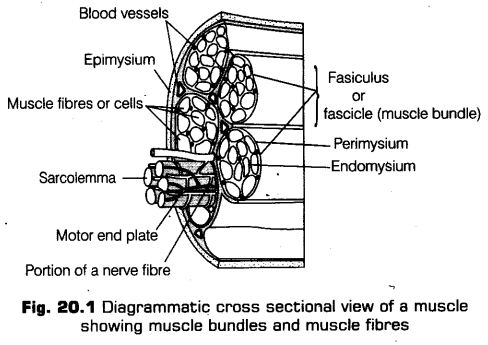
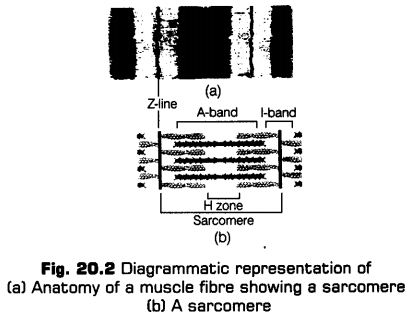
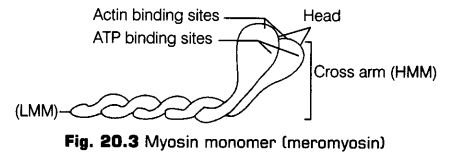


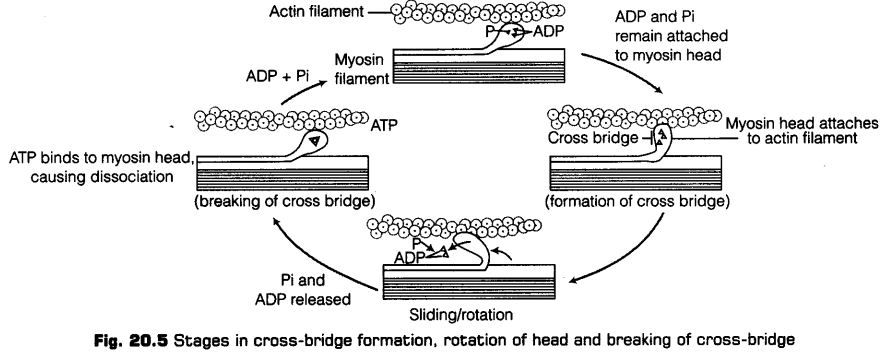
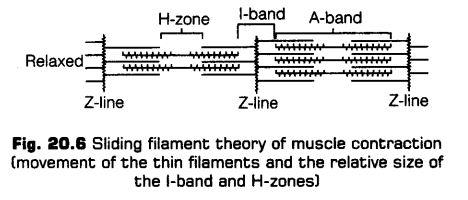
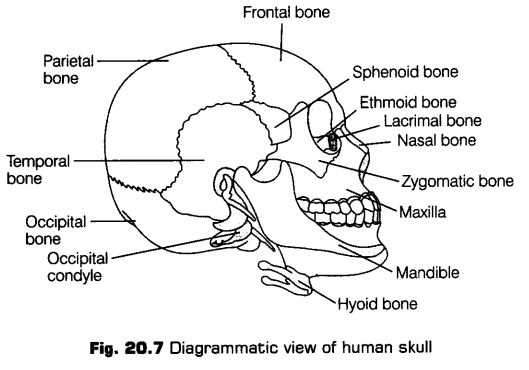
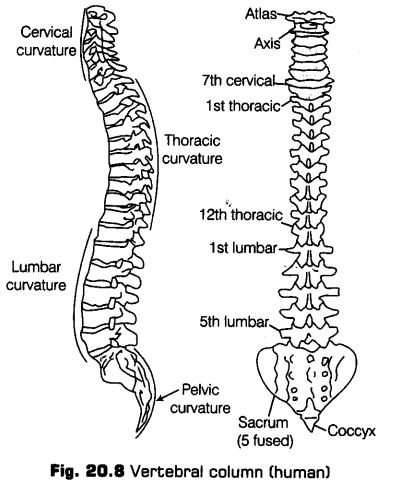
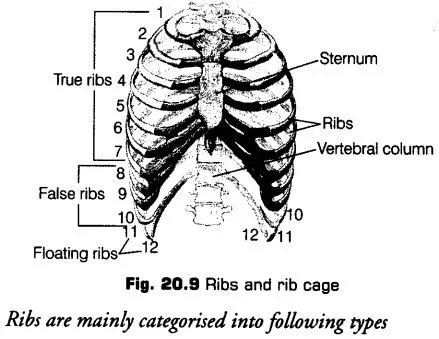
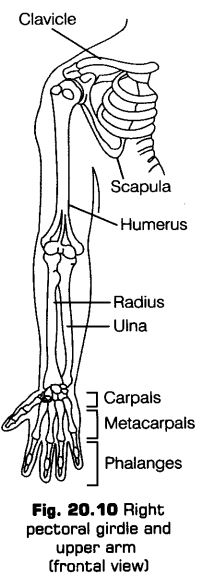
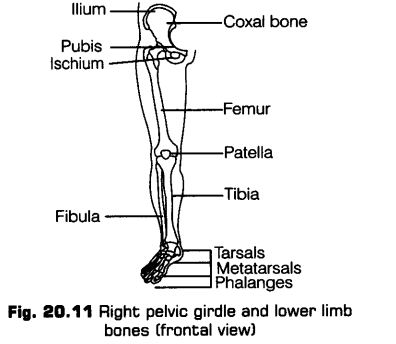
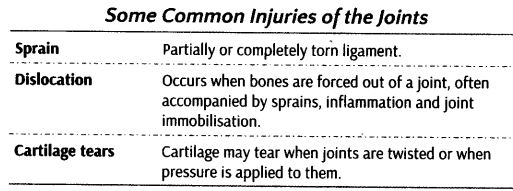
Leave a Reply